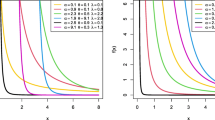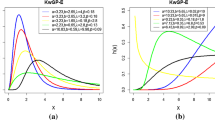Abstract
This paper introduces a parametric finite mixture model (FMM) approach to analyze the dependent competing risks data subjected to progressive first-failure censoring and multiple causes of failure. The cause-specific failure times are assumed to be flexibly modeled by the Lehmann family of distributions (also known as the exponentiated distributions) with variation in both distribution parameters. Application of the expectation maximization (EM) algorithm facilitates the maximum likelihood estimation of the model parameters and illuminates the contribution of the censored data. For interval estimation purposes, we resort to using the asymptotic confidence intervals based on the observed Fisher information matrix. Practitioners often prefer employing simpler lifetime distribution in order to facilitate the data modeling process while knowing the true distribution. In this context, the effects of model misspecification are studied based on the p-th quantile when the true distribution is misspecified. An extensive simulation study is performed to validate our proposed model. Finally, an automotive warranty claims data set is used as an illustration to study the effectiveness of our proposed model, assuming some important members of the Lehmann family, like generalized exponential and exponentiated Pareto distributions.









Similar content being viewed by others
References
Abdel-Qadir, H., Fang, J., Lee, D.S., Tu, J.V., Amir, E., Austin, P.C., Anderson, G.M.: Importance of considering competing risks in time-to-event analyses: application to stroke risk in a retrospective cohort study of elderly patients with atrial fibrillation. Circ. Cardiovasc. Qual. Outcomes 11(7), e004580 (2018). https://doi.org/10.1161/circoutcomes.118.004580
Babu, G.J., Rao, C.R., Rao, M.B.: Non-parametric estimation of specific exposure rate in risk and survival analysis. J. Am. Stat. Assoc. 87, 84–89 (1992). https://doi.org/10.2307/2290455
Balakrishnan, N., Sandhu, R.A.: A simple simulational algorithm for generating progressive type-II censored samples. Am. Stat. 49, 229–230 (1995). https://doi.org/10.1080/00031305.1995.10476150
Cox, D.R.: The analysis of exponentially distributed lifetimes with two types of failures. J. R. Stat. Soc. Ser. B (Methodol.) 21, 411–421 (1959)
Crowder, M.J.: Classical Competing Risks. Chapman and Hall, London (2001)
Escarela, G., Russell, J.B.: Fitting a semi-parametric mixture model for competing risks in survival data. Commun. Stat. Theory Methods 2, 277–293 (2008). https://doi.org/10.1080/03610920701649134
Feizjavadian, S.H., Hashemi, R.: Analysis of dependent competing risks in the presence of progressive hybrid censoring using Marshall–Olkin bivariate weibull distribution. Comput. Stat. Data Anal. 82, 19–34 (2015). https://doi.org/10.1016/j.csda.2014.08.002
Gupta, R.D., Kundu, D.: Exponentiated exponential family: an alternative to Gamma and Weibull distributions. Biom. J. J. Math. Methods Biosci. 43(1), 117–130 (2001). https://doi.org/10.1002/1521-4036
Hernandez-Quintero, A., Dupuy, J.F., Escarela, G.: Analysis of a semiparametric mixture model for competing risks. Ann. Inst. Stat. Math. 63, 305–329 (2011). https://doi.org/10.1007/s10463-009-0229-1
Khakifirooz, M., Tseng, S.T., Fathi, M.: Model misspecification of generalized gamma distribution for accelerated lifetime-censored data. Technometrics 62, 357–370 (2020). https://doi.org/10.1080/00401706.2019.1647880
Kundu, D., Basu, S.: Analysis of incomplete data in presence of dependent competing risks. Statistical Methods and Practice: Recent Advances, Editors N. Balakrishnan, N. Kannan and M.R. Srinivasan, Narosa Publishing House, 313–322 (2003)
Kundu, D., Raqab, M.Z.: Generalized Rayleigh distribution: different methods of estimations. Comput. Stat. Data Anal. 49(1), 187–200 (2005). https://doi.org/10.1016/j.csda.2004.05.008
Kundu, D., Kannan, N., Mazumdar, M.: Inference on risk rates based on mortality data under censoring and competing risks using parametric models. Biom. J. 34, 315–328 (1992). https://doi.org/10.1002/bimj.4710340306
Lin, T.: Robust mixture modeling using multivariate skew t distributions. Stat. Comput. 20, 343–356 (2010)
Maleki, M., Wraith, D., Arellano-Valle, R.B.: Robust finite mixture modeling of multivariate unrestricted skew-normal generalized hyperbolic distributions. Stat. Comput. 29, 415–428 (2019)
McLachlan, G.J., McGiffin, D.C.: On the role of finite mixture models in survival analysis. Stat. Methods Med. Res. 3, 211–226 (1994). https://doi.org/10.1177/096228029400300302
Mudholkar, G.S., Srivastava, D.K.: Exponentiated Weibull family for analyzing bathtub failure-rate data. IEEE Trans. Reliab. 42(2), 299–302 (1993). https://doi.org/10.1109/24.229504
Pal, A., Prajapati, D.: Mixture model for dependent competing risks data and application for diabetic retinopathy treatment. Appl. Math. Model. 113, 514–527 (2023). https://doi.org/10.1016/j.apm.2022.09.003
Shawky, A., Abu-Zinadah, H.: Exponentiated pareto distribution: different method of estimations. Int. J. Contemp. Math. Sci. 4(14), 677–693 (2009)
Somboonsavatdee, A., Sen, A.: Statistical inference for power-law process with competing risks. Technometrics 57, 112–122 (2015). https://doi.org/10.1080/00401706.2014.902772
White, H.: Maximum likelihood estimation of misspecified models. Econom. J. Econom. Soc. (1982). https://doi.org/10.2307/1912526
Wu, S.J., Kuş, C.: On estimation based on progressive first-failure-censored sampling. Comput. Stat. Data Anal. 53(10), 3659–3670 (2009). https://doi.org/10.1016/j.csda.2009.03.010
Acknowledgements
The authors would like to thank the associate editor and two anonymous reviewers for their careful reading and constructive comments which have helped to improve the manuscript significantly.
Funding
No funding has been received by any of the authors for this manuscript.
Author information
Authors and Affiliations
Contributions
Deepak Prajapati wrote the main manuscript text and done the conceptual and simulation study. Ayan Pal contribute in writing the manuscript with simulation study. Debasis Kundu reviewed the manuscript and helped in conceptual part.
Corresponding author
Ethics declarations
Conflicts of interests/Conflict of interest
The authors do not have any conflict of interests or competing interests for this manuscript.
Additional information
Publisher's Note
Springer Nature remains neutral with regard to jurisdictional claims in published maps and institutional affiliations.
Appendix: Elements of Fisher Information Matrix
Appendix: Elements of Fisher Information Matrix
1.1 General Case
Suppose \(\varvec{\theta }=(\theta _1,\theta _2,\ldots ,\theta _{3S-1})=(\phi _1,\phi _2,\ldots ,\phi _{S-1},\alpha _{1},\alpha _{2},\ldots ,\alpha _{S},\lambda _{1},\lambda _{2},\ldots ,\lambda _{S}),\) and for \(i,j=1,2,\ldots ,3S-1,\) \( I(\varvec{\theta }) = \Bigg (\Bigg (\dfrac{\partial ^2\,l(\varvec{\theta }|{\varvec{t,\,\delta }})}{\partial \theta _i \partial \theta _j }\Bigg )\Bigg )\) be the observed Fisher information matrix. Note that here \(l=l(\varvec{\theta }|\varvec{t,\,\delta })\) is the log-likelihood function as defined in (2.5). For \(j,k=1,2,\ldots ,S-1,\,j\ne k, \) and \(x,\,y=1,2,\ldots ,S,\,x \ne y,\) the elements of the observed Fisher information matrix can then be expressed as follows:
where
Rights and permissions
Springer Nature or its licensor (e.g. a society or other partner) holds exclusive rights to this article under a publishing agreement with the author(s) or other rightsholder(s); author self-archiving of the accepted manuscript version of this article is solely governed by the terms of such publishing agreement and applicable law.
About this article
Cite this article
Prajapati, D., Pal, A. & Kundu, D. A finite mixture model for multiple dependent competing risks with applications of automotive warranty claims data. Stat Comput 34, 19 (2024). https://doi.org/10.1007/s11222-023-10326-z
Received:
Accepted:
Published:
DOI: https://doi.org/10.1007/s11222-023-10326-z




